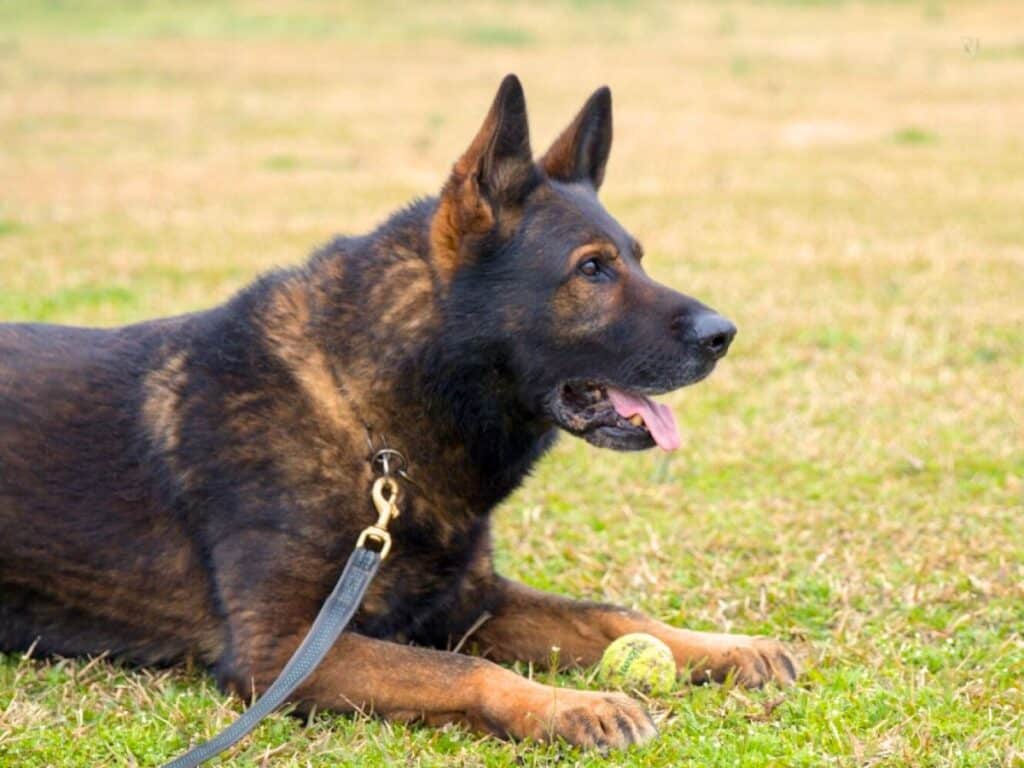If you’re a proud owner of a 10-month-old German Shepherd, then you know firsthand the joy and challenges that come with this stage of their development.
German Shepherds, known for their intelligence and versatility, require special attention during this adolescent phase.
So, if you’re seeking guidance on understanding their growth patterns, and managing their behavior and training needs, look no further.
10 Month Old German Shepherd: In a Nutshell
At 10 months of age, a German Shepherd is transitioning from puppyhood to adolescence, displaying a unique set of characteristics.
The following table outlines key details about a typical 10-month-old German Shepherd, providing insights into their size, weight, behavior, and health considerations.
| Size | Medium to large |
| Weight | Male: 66 – 73 pounds Female: 57 – 62 pounds |
| Height | Male: 22-24 inches Female: 19-21 inches |
| Ears | Erect and triangular |
| Teeth | Adult teeth are fully developed |
| Behavior | Energetic, intelligent, and eager to learn. May display adolescent behaviors, such as testing boundaries & stubbornness. |
| Exercise Needs | High – requires regular 30 mins – 1 hour of exercise and mental stimulation |
| Feeding | High-quality dog food, 2 times/day or as recommended by the vet. |
| Training | Responds well to positive reinforcement training; basic obedience commands should be well-established |
These details serve as a general guide, and individual dogs may vary. Always consult with a veterinarian for personalized advice on the care and well-being of your German Shepherd.

10 Month Old German Shepherd Size
At this stage, German Shepherds typically reach about 60-70% of their adult height. They have gone through a significant growth spurt and are now much taller than they were as puppies.
Their muscles become more defined, giving them a strong and athletic appearance. However, it’s important to note that they may continue to fill out in the coming months.
Average Size (Height)
The height at the shoulder for a 10-month-old male German Shepherd is usually around 22 to 24 inches, while females are typically around 19 to 21 inches tall at this age.
How much should a 10 month old German Shepherd weigh?
At 10 months, male German Shepherds typically weigh between 66 to 73 pounds, while female German Shepherds at 10 months generally weigh between 57 to 62 pounds.
However, it’s important to remember that these numbers are just averages and should not be considered as strict rules.
Ensuring healthy growth in your pup goes beyond just monitoring their weight gain. It also involves providing them with a balanced diet, regular exercise, and proper veterinary care.
A well-rounded approach to their overall health will contribute to their growth and development in a positive way.
German Shepherd Growth Chart
To get a better understanding of how your 10 month old German Shepherd’s weight & height compare to the breed standards, consulting a growth chart can be incredibly helpful.
The chart below provides valuable insights into the expected height and weight range for different ages and both genders of German Shepherds.

By comparing your dog’s growth against these standards, you can ensure that they are on track with their growth and development.
RELATED:

10 Month Old German Shepherd Behavior
When it comes to a 10-month-old German Shepherd, you can expect to see some significant behavioral changes. Just like humans going through puberty, these furry friends are also experiencing their own version of adolescence.
- Increased Independence: As German Shepherds approach adolescence, they tend to display a growing sense of independence. They may become more confident and less reliant on constant supervision.
- High Energy Levels: Playfulness persists, and 10-month-old German Shepherds require regular and vigorous exercise to release pent-up energy. Daily walks, play sessions, and mentally stimulating activities are essential to keep them engaged and prevent boredom.
- Testing Boundaries: Adolescence often brings about a testing of boundaries. German Shepherds may challenge authority or push limits to assert themselves.
- Heightened Curiosity: At this age, German Shepherds become more curious about their surroundings. They will explore their environment with increased interest and may exhibit investigative behaviors such as sniffing, digging, or chewing.
- Intelligence and Learning: German Shepherds are highly intelligent, and at 10 months, they continue to be eager learners. They may pick up new commands quickly and enjoy mental stimulation through puzzle toys or problem-solving activities.
- Protective Instincts: The protective instincts inherent in German Shepherds may become more apparent. They may start to display alertness to unfamiliar people or situations.
- Bonding with Family: The bond between the German Shepherd and its family deepens. They become more attuned to family members and may exhibit increased loyalty and affection.
So don’t be alarmed if you see any of these behaviors in your adolescent GSD. Remember, while these behavioral changes can be challenging at times, they are a normal part of your German Shepherd’s development.
Based on my experience as a parent to 3 German Shepherds, I have also written a detailed article on Common German Shepherd Behaviors and another article about German Shepherd Signs of Affection. Don’t forget to check them out!

Training a 10 Month Old German Shepherd
Training a 10-month-old German Shepherd can be both challenging and rewarding. At this age, your German Shepherd is entering adolescence and may exhibit some stubbornness and independence.
However, with the right approach and consistency, you can shape your dog into a well-behaved and obedient companion. Here are some tips to help you in training your pup:
- Establish yourself as the pack leader: German Shepherds are known for their loyalty and desire to please their owners. Show your dog that you are the leader by setting boundaries, enforcing rules, and rewarding good behavior.
- Start with basic obedience commands: Begin training by teaching your German Shepherd basic obedience commands such as “sit,” “stay,” “down,” and “come.” These commands form the foundation of more advanced training and will help establish control and discipline.
- Leash Training: Reinforce proper leash manners and introduce the “heel” command. A well-behaved German Shepherd on a leash is not only more enjoyable for walks but also safer for both the dog and the owner.
- Distraction Training: Train your German Shepherd to focus on you, especially in distracting environments. This is crucial for maintaining control and reinforcing obedience in various situations.
- Introduce Advanced Commands: Consider introducing more advanced commands such as “leave it,” “wait,” or “place.” These commands enhance your dog’s training and responsiveness.
- Provide mental stimulation: German Shepherds are intelligent dogs that require mental stimulation. Engage your dog in activities such as puzzle toys, obedience training, or scent work to keep their mind active and prevent boredom.
- Exercise regularly: German Shepherds have high energy levels and require regular exercise to stay happy and healthy. Take your dog for daily walks, play fetch, or engage in other physical activities to burn off excess energy and prevent destructive behavior.
- Seek professional help if needed: If you’re struggling with training your 10-month-old German Shepherd, don’t hesitate to seek professional help from a dog trainer or behaviorist. They can provide guidance and personalized training techniques to address specific issues.
Remember, training a 10-month-old German Shepherd requires patience, consistency, and positive reinforcement. With time and effort, you can shape your dog into a well-behaved and obedient companion that brings joy to your life.
RELATED:
- 30 German Shepherd Training Commands & Free PDF
- How To Stop a German Shepherd From Pulling on The Leash

Feeding Guide for a 10-Month-Old German Shepherd
Feeding your 10-month-old German Shepherd is an important aspect of their overall health and well-being. As they continue to grow and develop, their nutritional needs change.
In this guide, we will provide you with some tips and recommendations to ensure your furry friend receives the proper nourishment they need.
Feeding Schedule
Establishing a regular feeding schedule is essential for your German Shepherd’s digestion and overall routine.
At 10 months old, your German Shepherd can transition from three meals a day to two meals a day.
Here’s a simple feeding schedule you can follow:
- Morning: Start the day by offering your German Shepherd a balanced meal of high-quality dry dog food. Measure the appropriate amount based on the manufacturer’s guidelines for their age and weight.
- Afternoon: Provide a small snack or treat during the day to keep your pup satisfied. Opt for healthy options like carrot sticks or dog-friendly fruits.
- Evening: Offer another portion of dry dog food in the evening, similar to the morning meal. Again, follow the recommended serving size on the packaging.
- Bedtime: Before your German Shepherd settles down for the night, give them a final small snack or treat. This helps prevent hunger during the night and promotes better sleep.
RELATED: German Shepherd Feeding Chart By Age
Feeding Tips
- Choose a high-quality dog food specifically formulated for large breed puppies or young German Shepherds. Look for options that contain real meat as the main ingredient and avoid foods with excessive fillers or artificial additives.
- Avoid overfeeding your 10-month-old German Shepherd, as it can lead to weight gain and potential health issues (Source). Follow the guidelines on the dog food packaging as a starting point but also consider your dog’s activity level and metabolism.
- Provide fresh water at all times. Hydration is crucial for your German Shepherd’s overall health and digestion.
- Consider incorporating some fresh, dog-safe fruits and vegetables into their diet as occasional treats or meal toppers. Apples, blueberries, carrots, and green beans are all excellent choices.
- Choose high-quality treats made specifically for dogs, and limit them to no more than 10% of your dog’s daily caloric intake.
- Monitor your dog’s digestion and adjust their diet if necessary. If your German Shepherd experiences digestive issues or allergies, consult with a veterinarian for guidance on appropriate dietary changes.
RELATED: What Do German Shepherds Eat?
How much should a 10 month old German Shepherd eat?
A 10-month-old German Shepherd should typically eat about 2 to 3 cups of high-quality dog food per day, divided into two or three meals. However, it’s important to note that the exact amount may vary depending on the individual dog’s size, activity level, metabolism, and overall health.
It’s always best to consult with a veterinarian to determine the specific dietary needs of your German Shepherd based on their age, weight, and any other relevant factors.
Additionally, it’s important to monitor your dog’s body condition and adjust their food intake accordingly to ensure they maintain a healthy weight.
Transitioning to Adult Food: When and How
Around 12 months of age, your German Shepherd will be ready to transition from puppy food to adult food. Gradually introduce the new food by mixing it with their current food over 7-10 days. This slow transition will help prevent digestive upset.
Check out this video of a 10 month old German Shepherd…

Exercise and Activity Guidelines
German Shepherds are an active and intelligent breed that requires regular exercise to stay happy and healthy. Here are some guidelines to keep in mind:
- Physical Exercise
- 10 month old GSDs require at least 60-90 minutes of exercise every day.
- Engage in activities such as brisk walks, jogging, hiking, or playing fetch in a secure area.
- Consider incorporating interactive toys or puzzle games to keep them mentally stimulated while exercising.
- Mental Stimulation
- German Shepherds are highly intelligent and thrive on mental challenges.
- Provide them with puzzle toys, treat-dispensing toys, or interactive games that require problem-solving skills.
- Engage in obedience training sessions to keep their minds sharp and reinforce good behavior.
- Avoid Overexertion
- While it’s important to provide ample exercise, be mindful not to overexert your GSD.
- Avoid intense physical activities such as long-distance running or excessive jumping, as their joints are still developing.
Establish a consistent exercise routine for your German Shepherd. Aim for regular exercise sessions at the same time each day to help them anticipate and look forward to their activity time.
RELATED: How Much Exercise Does a German Shepherd Need Daily?

Spaying or Neutering Your GSD
The ideal time to spay or neuter a German Shepherd is a topic of debate among veterinarians. Some suggest waiting until they are at least one year old to ensure proper growth and development.
However, others argue that early spaying/neutering at around six months old has its advantages.
Early spaying/neutering may offer better protection against certain diseases like mammary tumors in females if done before their first heat cycle. It can also prevent behavioral problems that may arise during adolescence when hormones are more active.
On the other hand, delaying spaying/neutering until one year old allows for full skeletal development before altering hormone levels. This approach may reduce the risk of orthopedic issues such as hip dysplasia or cruciate ligament injuries.
Ultimately, it’s essential to consult with your veterinarian to determine the best timing based on your individual dog’s health, breed characteristics, and lifestyle factors.
Conclusion
By now, you have gained valuable insights into the growth, behavior, training, health, and daily care needs of your 10 month old German Shepherd. Armed with this knowledge, you are well-equipped to provide the best possible care for your furry friend.
But remember, owning a German Shepherd is not just about meeting their physical needs. It’s about building a strong bond and nurturing their mental well-being. Take the time to understand your dog’s unique personality and provide them with the love, attention, and mental stimulation they crave. With patience, consistency, and positive reinforcement training methods, you can mold your German Shepherd into a well-behaved and happy companion.
Frequently Asked Questions
1. Can a 10-month-old German Shepherd still grow in size?
Yes, a 10-month-old German Shepherd can still experience growth in size. At this stage, they are approaching their adult height and weight, but there may be some additional growth until they reach full maturity at around 18-24 months.
2. How much exercise does a 10-month-old German Shepherd need?
A 10-month-old German Shepherd requires regular exercise to stay healthy and burn off energy. Aim for at least an hour of physical activity each day, including walks, playtime, and mental stimulation.
3. Should I spay or neuter my 10-month-old German Shepherd?
The decision to spay or neuter your 10-month-old German Shepherd should be discussed with your veterinarian. Spaying or neutering can help prevent certain health issues and unwanted behaviors. It is best to consult with professionals who can guide you based on your dog’s specific circumstances.
4. What should I feed my 10-month-old German Shepherd?
A balanced diet is crucial for the health of your 10-month-old German Shepherd. Choose high-quality dog food formulated for large breeds, providing essential nutrients like protein and vitamins. Consult with your vet to determine the appropriate portion sizes based on your dog’s weight and activity level.




